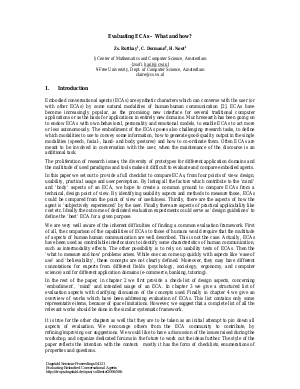Evaluating ECAs - What,how and why?
Authors Zsofia Ruttkay, Claire Dormann, Han Noot
-
Part of:
Volume:
Dagstuhl Seminar Proceedings, Volume 4121
Part of: Series: Dagstuhl Seminar Proceedings (DagSemProc) - License:
 Creative Commons Attribution 4.0 International license
Creative Commons Attribution 4.0 International license
- Publication Date: 2006-06-27
File

PDF
DagSemProc.04121.4.pdf
- Filesize: 64 kB
- 8 pages
Document Identifiers
Subject Classification
Keywords
- Embodied conversational agents
- design
- evaluation framework
- methodology
Metrics
- Access Statistics
-
Total Accesses (updated on a weekly basis)
0Document
0Metadata
Abstract
One would like to rely on design guidelines for embodied conversational agents (ECAs), grounded on evaluation studies. How to define the physical and mental characteristics of an ECA, optimal for an envisioned application? What will be the added value of using an ECA? Although there have been studies addressing such issues, we are still far from getting a complete picture. This is not only due to the still relatively little experience with applications of ECAs, but also to the diversity in terms and experimental settings used. The lack of a common, established framework makes it difficult to compare ECAs, interpret evaluation results and judge their scope and relevance. In this paper we propose a common taxonomy of the relevant design and evaluation aspects of ECAs. We refer to recent works to elicit evaluation concepts and discuss measurement issues.
Cite As Get BibTex
Zsofia Ruttkay, Claire Dormann, and Han Noot. Evaluating ECAs - What,how and why?. In Evaluating Embodied Conversational Agents. Dagstuhl Seminar Proceedings, Volume 4121, pp. 1-8, Schloss Dagstuhl – Leibniz-Zentrum für Informatik (2006)
https://doi.org/10.4230/DagSemProc.04121.4
BibTex
@InProceedings{ruttkay_et_al:DagSemProc.04121.4,
author = {Ruttkay, Zsofia and Dormann, Claire and Noot, Han},
title = {{Evaluating ECAs - What,how and why?}},
booktitle = {Evaluating Embodied Conversational Agents},
pages = {1--8},
series = {Dagstuhl Seminar Proceedings (DagSemProc)},
ISSN = {1862-4405},
year = {2006},
volume = {4121},
editor = {Zsofia Ruttkay and Elisabeth Andr\'{e} and W. Lewis Johnson and Catherine Pelachaud},
publisher = {Schloss Dagstuhl -- Leibniz-Zentrum f{\"u}r Informatik},
address = {Dagstuhl, Germany},
URL = {https://drops.dagstuhl.de/entities/document/10.4230/DagSemProc.04121.4},
URN = {urn:nbn:de:0030-drops-5867},
doi = {10.4230/DagSemProc.04121.4},
annote = {Keywords: Embodied conversational agents, design, evaluation framework, methodology}
}
